Unquillosaurus is a genus of possible maniraptoran or carnosaurian theropod dinosaur from the Late Cretaceous Los Blanquitos Formation of Salta Province, Argentina. The genus contains a single species, U. ceibalii, known only from a single fossilized pubis.
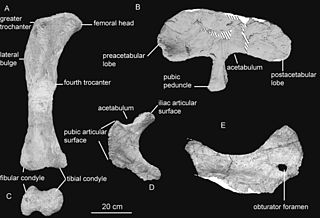
Rocasaurus is a genus of titanosaurian sauropod that lived in South America. Rocasaurus was discovered in Argentina in 2000, within the Allen Formation which is dated to be middle Campanian to early Maastrichtian in age. This genus grew up to 8 metres (26 ft) long, making it one of the smaller sauropods. It seems to be closely related to saltasaurid dinosaurs, like Saltasaurus and Neuquensaurus.
The Huincul Formation is a geologic formation of Late Cretaceous age of the Neuquén Basin that outcrops in the Mendoza, Río Negro and Neuquén Provinces of northern Patagonia, Argentina. It is the second formation in the Río Limay Subgroup, the oldest subgroup within the Neuquén Group. Formerly that subgroup was treated as a formation, and the Huincul Formation was known as the Huincul Member.
The Portezuelo Formation is a geologic formation of Late Cretaceous age, outcropping in the Mendoza, Río Negro and Neuquén provinces of Argentina. It is the fourth-oldest formation in the Neuquén Group and the older of the two formations in the Río Neuquén Subgroup. Formerly, that subgroup was treated as a formation, and the Portezuelo Formation was known as the Portezuelo Member.
The Bajo de la Carpa Formation is a geologic formation of the Neuquén Basin that crops out in northern Patagonia, in the provinces of Río Negro and Neuquén, Argentina. It is the oldest of two formations belonging to the Río Colorado Subgroup within the Neuquén Group. Formerly, that subgroup was treated as a formation, and the Bajo de la Carpa Formation was known as the Bajo de la Carpa Member.

The Anacleto Formation is a geologic formation with outcrops in the Argentine Patagonian provinces of Mendoza, Río Negro, and Neuquén. It is the youngest formation within the Neuquén Group and belongs to the Río Colorado Subgroup. Formerly that subgroup was treated as a formation, and the Anacleto Formation was known as the Anacleto Member.

Vincelestes is an extinct genus of mammal that lived in what is now South America during the Early Cretaceous. It is closely related to modern therian mammals as part of Cladotheria.
The Los Alamitos Formation is a geological formation of the North Patagonian Massif in Rio Negro Province, northwestern Patagonia, Argentina, whose strata date back to the Late Cretaceous. Dinosaur remains are among the fossils that have been recovered from the formation.

The Allen Formation is a geological formation in Argentina whose strata date back to the Late Cretaceous (middle Campanian to early Maastrichtian. Dinosaur remains are among the fossils that have been recovered from the formation. Indeterminate chelid remains and other vertebrates have also been discovered in this formation.

Patagopterygiformes is an extinct group of large terrestrial ornithuromorph dinosaurs from the Late Cretaceous of South America. It contains at most three genera: Patagopteryx, Alamitornis and possibly Kuszholia.
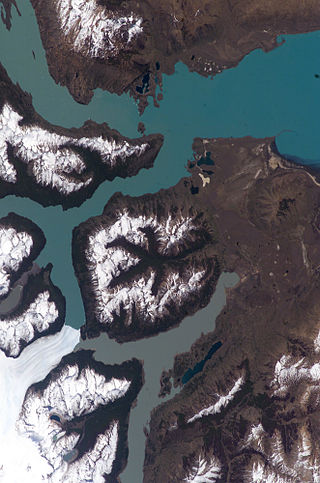
The Chorrillo Formation, also named as Chorillo Formation, is a Maastrichtian geologic formation in southern Patagonia, Argentina. The formation is more than 50 metres (160 ft) thick and underlies the Calafate Formation and rests on top of the La Irene Formation.
The Angostura Colorada Formation is a Campanian to Maastrichtian geologic formation of the Neuquén Basin and North Patagonian Massif in the Río Negro Province of Argentina. Dinosaur remains diagnostic to the genus level are among the fossils that have been recovered from the formation.
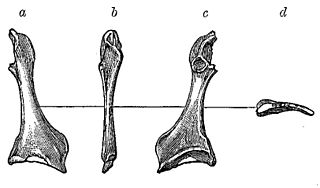
Cimolopterygidae is an extinct family of ornithurines known from the Late Cretaceous epoch. Remains attributed to cimolopterygids have been found in the Frenchman Formation of Saskatchewan, the Lance Formation of Wyoming, the Fox Hills Formation of Colorado, the Hell Creek Formation of Montana, and the Allen Formation of Rio Negro, Argentina. Most date to the end of the Maastrichtian age, about 66 million years ago, though a much earlier species has also been identified from the Campanian-aged Dinosaur Park Formation of Alberta, about 75 million years ago.
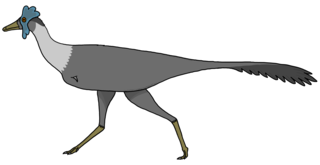
Bonapartenykus is a monospecific genus of alvarezsauroid dinosaur from Argentina that lived during the Late Cretaceous (Campanian-Maastrichtian) in what is now the upper Allen Formation of the Río Negro Province. The type and only species, Bonapartenykus ultimus, is known from a nearly articulated but partial skeleton that was found in close association to two incomplete eggs and several clusters of eggshells belonging to the oogenus Arriagadoolithus. Bonapartenykus was named in 2012 by Federico L. Agnolin, Jaime E. Powell, Fernando E. Novas and Martin Kundrát. Bonapartenykus has an estimated length of 2.5 m (8.2 ft) and weight of 72 kg (159 lb), making it the largest member of the clade Alvarezsauroidea.

Niebla is a genus of abelisaurid theropod dinosaur from the Late Cretaceous Period (Campanian-Maastrichtian) of Río Negro province, Argentina. The genus contains a single species, Niebla antiqua, and is known from a partial, non-articulated skeleton. The holotype, found in the Allen Formation, represents an adult individual.
Guemesia is a genus of abelisaurid dinosaur from the Late Cretaceous Los Blanquitos Formation of Salta Province, Argentina. The type and only species is Guemesia ochoai, known from a nearly complete braincase. It is one of the smallest abelisaurids currently known.
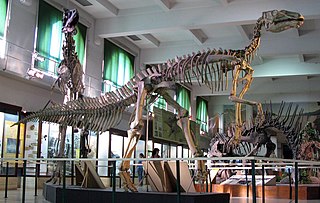
Huallasaurus is an extinct genus of saurolophine hadrosaur from the Late Cretaceous Los Alamitos Formation of Patagonia in Argentina. The type and only species is H. australis. Originally named as a species of Kritosaurus in 1984, it was long considered a synonym of Secernosaurus before being recognized as its own distinct genus in a 2022 study, different from other members of Kritosaurini.

Maip is a genus of large megaraptorid theropod dinosaur from the Late Cretaceous (Maastrichtian) Chorrillo Formation of Santa Cruz, Argentina. The genus contains a single species, M. macrothorax, known from an incomplete, disarticulated skeleton. Maip may represent the largest megaraptorid known from South America, and possibly the world.
Patagopelta is an extinct genus of ankylosaurian dinosaur from the Late Cretaceous Allen Formation of Argentina. The genus contains a single species, P. cristata, known from a partial skeleton. While originally described as a nodosaurine, later discoveries provided support for parankylosaurian affinities for the taxon. Patagopelta is a very small ankylosaur, comparable in size to the dwarf nodosaurid Struthiosaurus, about 2 m (6.6 ft) long.

Yatenavis is an extinct genus of enantiornithine bird from the Late Cretaceous Chorrillo Formation of Santa Cruz Province, Argentina. The genus contains a single species, Y. ieujensis, known from a partial humerus.





















